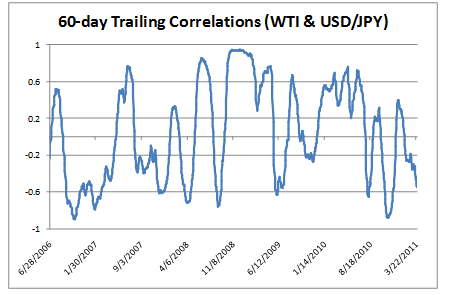
Earlier in our post on Correlation Coefficients, we had stated that correlations change over time and that it is important to calculate the measure for different periods and window lengths. Trailing correlations are a graphical representation of this concept. Here we calculate the correlation coefficient using data over a set window length, say 60 days, and then roll the window length forwards by a day recalculating the coefficient for each new 60-day period. The result of this “moving average” calculation is as demonstrated in the following graph:
The graph above shows 60-day trailing correlations of WTI and Brent spot prices. We can see that the correlations are quite stable, mostly lying near 1, i.e. perfectly positive correlations. Even here we see that correlations may vary, for example in early Feb 2011 we see a significant breakdown in historical correlations between WTI and Brent as a result of the recent Arab revolutions.

For a different picture of how trailing correlations may pan out for two variables consider the graph for WTI and the USD/JPY exchange rate below:
In this instance the trailing correlations are all over the place- there is significant instability in correlation coefficient results. Relying on any given point estimate of the correlation coefficient could be hazardous because correlations between these two factors have varied significantly over the period being considered.

Comments are closed.